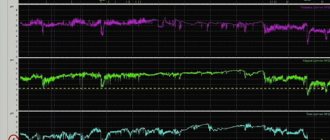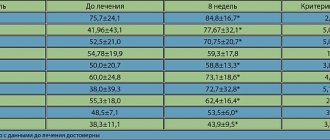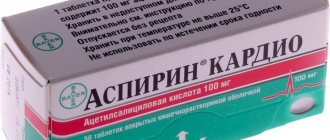Aspirin is a popular drug in the category of non-steroidal anti-inflammatory drugs. It is also used for the prevention of diseases of the cardiovascular system. There is one persistent myth that aspirin thins the blood and is indicated for the prevention of cardiovascular diseases. However, this is not entirely true. Aspirin affects blood clotting and, as a result, the process of thrombus formation. But the thickness of the blood is affected by the amount of hemoglobin and red blood cells. The lower their value, the more liquid the blood in the body.
In this article we will consider in detail the drug aspirin cardio. How does it differ from the usual simple aspirin, what effect does it have on the body and cardiac activity in particular.
Medicine aspirin cardio
In addition to the fact that the drug belongs to the category of NSAIDs and has an antipyretic effect and analgesic effect, aspirin cardio is used in the primary prevention of diseases of the cardiovascular system and in the secondary prevention of myocardial infarction. Reduces the risk of developing the disease with unstable angina. The drug is prescribed for cardiovascular pathologies due to its antithrombotic effect.
The main difference between the drug and regular aspirin is that aspirin cardio is coated with a special enteric coating. Due to this, it is used for long courses in cardiology. This coating allows the active substance to be released in the intestines, thereby minimizing one of the main side effects of aspirin - damage to the gastric mucosa.
Composition of the drug
The active ingredient of the drug is acetylsalicylic acid.
Excipients include corn starch and cellulose powder.
The enteric coating contains polysorbate, sodium lauryl sulfate, talc and other compounds.
Thus, when prescribing the drug, individual intolerance to the components of the composition should be taken into account.
Release form and dosage
The drug aspirin cardio is available only in the form of enteric-coated tablets in dosages of 100 mg and 300 mg.
The number of tablets in a package can be: 20 pcs., 28 pcs., 56 pcs.
Indications for aspirin cardio
- Primary prevention of acute myocardial infarction, taking into account aggravating risks - hypertension, diabetes mellitus, obesity, smoking.
- Prevention after a heart attack.
- Stable and unstable angina (including suspicion of acute myocardial infarction).
- Prevention of stroke (including in patients with transient cerebrovascular accident).
- Prevention of cerebrovascular accidents.
- Prevention of thromboembolism after operations on blood vessels and arteries (bypass surgery, endarterectomy, angioplasty and stenting).
- Prevention of deep vein thrombosis and thromboembolism of the pulmonary artery and its branches (including long-term immobilization as a result of extensive surgery).
Methods of application
The method of administration and dosage regimen of the drug depend on its release form and other factors. The optimal dosage regimen is determined by a specialist based on specific indications. It is advisable to take aspirin cardio tablets orally before meals with plenty of liquid, preferably at the same time, once a day.
The duration of therapy is determined by the doctor. The usually recommended dose is 100 mg 1 time per day, but the approach to the dosage regimen is individual. Depending on the indications, it may increase to 300 mg/day.
Primary prevention of acute myocardial infarction in the presence of risk factors: 100 mg/day or 300 mg every other day.
- The recommended dosage for the prevention of recurrent infarction is 100-300 mg/day.
- For unstable angina, as well as the onset of myocardial infarction, the initial dose is 100-300 mg. In this case, the first tablet is chewed to speed up absorption. The drug should be taken as soon as possible at the slightest suspicion of danger. For a month after the attack, a maintenance dose of 200-300 mg/day is recommended. Further, all treatment recommendations are prescribed by a specialist based on the patient’s vital signs.
- Prevention of stroke and cerebrovascular accident: 100-300 mg/day.
- Prevention of thromboembolism after vascular surgery: 100-300 mg/day.
- Prevention of deep vein thrombosis and pulmonary embolism: 100-200 mg/day or 300 mg every other day.
The compliance of the dosage form of a particular drug with the indications for use and dosage regimen should be strictly observed.
Aspirin Cardio, tablets coated. captivity. about. 100 mg, 28 pcs.
Salicylate intoxication (develops when taking ASA at a dose of more than 100 mg/kg/day for more than 2 days) can result from prolonged use of toxic doses of the drug as part of improper therapeutic use (chronic intoxication) or a single accidental or intentional intake of a toxic dose of the drug by adults or a child (acute intoxication).
Symptoms of chronic intoxication
salicylic acid derivatives are nonspecific and are often difficult to diagnose. Mild intoxication usually develops only after repeated use of large doses of the drug and is manifested by dizziness, vertigo, tinnitus, hearing loss, increased sweating, nausea and vomiting, headache and confusion. These symptoms disappear after reducing the dose of the drug. Tinnitus may appear when the concentration of ASA in the blood plasma is from 150 to 300 mcg/ml. More severe symptoms appear when plasma ASA concentrations are above 300 mcg/ml.
The main manifestation of acute intoxication
is a severe violation of the acid-base state, the manifestations of which may vary depending on the age of the patient and the severity of intoxication. In children, the most typical development is metabolic acidosis. Since the rate of absorption of ASA may be reduced due to delayed gastric emptying, the formation of stones, or the use of drugs resistant to the action of gastrointestinal juice, the severity of intoxication cannot be judged solely by changes in the concentration of salicylates in the blood plasma. Treatment of intoxication is carried out in accordance with accepted standards and depends on the severity of intoxication and the clinical picture and should be aimed mainly at accelerating the elimination of the drug and restoring the water-electrolyte balance and acid-base state.
Mild to moderate overdose symptoms:
tachypnea, hyperventilation, respiratory alkalosis; profuse sweating; nausea, vomiting; laboratory and instrumental data: alkalemia, alkaluria.
Symptoms of moderate to severe overdose:
respiratory alkalosis with compensatory metabolic acidosis; hyperpyrexia (extremely high body temperature); respiratory disorders (hyperventilation, non-cardiogenic pulmonary edema, respiratory depression, asphyxia); disorders of the cardiovascular system (heart rhythm disturbances, arterial hypotension, cardiac depression); disturbances of water and electrolyte balance (dehydration, impaired renal function from oliguria up to the development of renal failure); impaired glucose metabolism, ketosis; tinnitus, deafness; gastrointestinal bleeding; hematological disorders (from inhibition of platelet aggregation to coagulopathy); neurological disorders (toxic encephalopathy and depression of central nervous system function (drowsiness, confusion, coma, convulsions); laboratory and instrumental data: acidemia, aciduria, changes in blood pressure, ECG, hypokalemia, hypernatremia, hyponatremia, renal dysfunction, hyperglycemia, hypoglycemia (especially in children), ketoacidosis, prolongation of PT, hypoprothrombinemia.
Treatment of mild to moderate overdose:
gastric lavage, repeated administration of activated carbon, forced alkaline diuresis; restoration of water-electrolyte balance and acid-base state.
Treatment of moderate to severe overdose:
gastric lavage, repeated administration of activated carbon, forced alkaline diuresis; in severe cases - hemodialysis; restoration of water-electrolyte balance and acid-base state.
Contraindications
Express contraindications include:
- allergy to the active substance and components of the drug,
- Gastrointestinal diseases, including erosions, ulcers in the acute stage,
- diseases of the bronchopulmonary system
- hemorrhagic diathesis,
- pregnancy and lactation (the 1st and 3rd trimesters are considered especially dangerous)
- aortic aneurysm
- renal or liver failure
- and children under 15 years of age.
Special Recommendations
Aspirin cardio and chronic diseases
Particular caution should be exercised when taking aspirin for persons suffering from diseases of the respiratory system. The fact is that taking aspirin causes a narrowing of the bronchi, which can cause so-called aspirin asthma, or provoke asthma, which is in remission.
Aspirin cardio and childhood
When taken in its pure form in children, due to their young age, the concentration of glucose in the plasma can sharply decrease, in parallel with this, the level of ketone bodies in the blood increases, plasma acidification occurs, and fatty acids accumulate in the liver. These metabolic disturbances lead to swelling of tissues and organs.
Children become more than just lethargic. Aggravating symptoms such as cramps, diarrhea, rapid breathing and palpitations may occur. Up to loss of consciousness and severe muscle hypotension. Such conditions in children can be life-threatening, so the drug is contraindicated for them.
Aspirin cardio and alcohol
The combined use of alcohol and aspirin is not recommended. Alcohol and alcohol-containing products are known for their vasodilating properties. But in combination with aspirin, the effect can be most unexpected. The risks of bleeding increase, including in diseases of the gastrointestinal tract, exacerbation of liver diseases or the occurrence of any acute symptoms associated with this organ.
Aspirin cardio and pregnancy
The active substance freely and easily penetrates the placental barrier, which can lead to negative consequences for the fetus.
When used in the first trimester, it leads to the development of a “cleft palate” (cleft palate); in the third trimester, it causes inhibition of labor, premature closure of the ductus arteriosus in the fetus, disruption of the functioning of the pulmonary vessels and hypertension in the pulmonary circulation.
Acetylsalicylic acid is also excreted in breast milk, which increases the risk of bleeding in the baby due to impaired platelet function. Therefore, the advisability of using the drug during pregnancy and lactation should be justified by the specialist making the decision on the prescription.
Aspirin Cardio, 56 pcs., 100 mg, enteric-coated tablets
With simultaneous use, ASA enhances the effect of the drugs listed below; If it is necessary to simultaneously prescribe ASA with the listed drugs, the need to reduce the dose of these drugs should be considered:
- methotrexate - by reducing renal clearance and displacing it from protein binding; the combination of ASA with methotrexate is accompanied by an increased incidence of side effects from the hematopoietic organs; the use of Aspirin® Cardio together with methotrexate is contraindicated if the dose of the latter exceeds 15 mg per week (see section “Contraindications”); and possibly with caution - with a dose of methotrexate less than 15 mg per week;
- heparin and indirect anticoagulants - due to disruption of platelet function and displacement of indirect anticoagulants from binding with proteins; when used simultaneously with anticoagulants, thrombolytic and antiplatelet agents (ticlopidine), there is an increased risk of bleeding as a result of the synergism of the main therapeutic effects of the drugs used and increased damaging effects on the gastrointestinal mucosa;
- selective serotonin reuptake inhibitors, because possible increased risk of bleeding from the upper gastrointestinal tract (synergism with ASA);
- digoxin - due to a decrease in its renal excretion, which can lead to an overdose;
- hypoglycemic agents for oral administration (sulfonylurea derivatives) and insulin - due to the hypoglycemic properties of ASA itself in high doses and displacing sulfonylurea derivatives from communication with blood plasma proteins; this must be kept in mind when prescribing ASA to patients with diabetes mellitus receiving the listed drugs;
- simultaneous use with valproic acid increases its toxicity due to displacement from the connection with blood plasma proteins;
- NSAIDs, incl. derivatives of salicylic acid in high doses (increased risk of ulcerogenic effect and bleeding from the gastrointestinal tract as a result of synergistic action);
- ethanol (alcoholic drinks) - increased risk of damage to the gastrointestinal mucosa and prolongation of bleeding time as a result of the mutual enhancement of the effects of ASA and ethanol.
Simultaneous administration of ASA in high doses may weaken the effect of the drugs listed below. If it is necessary to simultaneously prescribe ASA with the listed drugs, you should consider the need to adjust the dose of the drugs listed below:
- any diuretics (when used together with ASA in high doses, a decrease in glomerular filtration rate is observed as a result of a decrease in PG synthesis in the kidneys);
- ACE inhibitors - there is a dose-dependent decrease in glomerular filtration rate (GFR) as a result of inhibition of PGs that have a vasodilatory effect, and, accordingly, a weakening of the hypotensive effect. The clinical significance of a decrease in GFR is observed when the daily dose of ASA is more than 160 mg. In addition, there is a decrease in the positive cardioprotective effect of ACE inhibitors prescribed to patients for the treatment of chronic heart failure. This effect also occurs when used in combination with ASA in large doses;
- drugs with uricosuric action - benzbromarone, probenecid - a decrease in the uricosuric effect due to competitive suppression of renal tubular excretion of uric acid.
When used simultaneously with ibuprofen, antagonism is observed against the irreversible platelet inhibition caused by the action of ASA, which leads to a decrease in the cardioprotective effects of ASA. Therefore, the combination of ASA with ibuprofen is not recommended in patients with an increased risk of cardiovascular disease.
When used simultaneously with systemic corticosteroids (with the exception of hydrocortisone or other corticosteroids used for replacement therapy of Addison's disease), there is an increase in the elimination of salicylates and, accordingly, a weakening of their effect. When using GCS and salicylates in combination, it should be remembered that the level of salicylates in the blood is reduced, and after discontinuation of GCS, an overdose of salicylates is possible.





